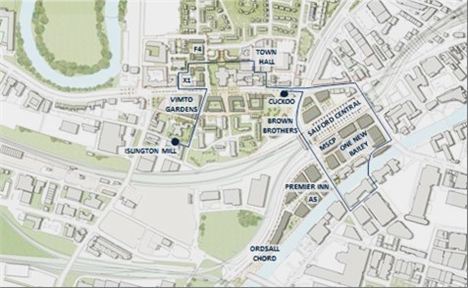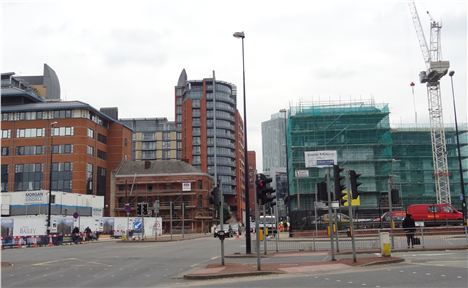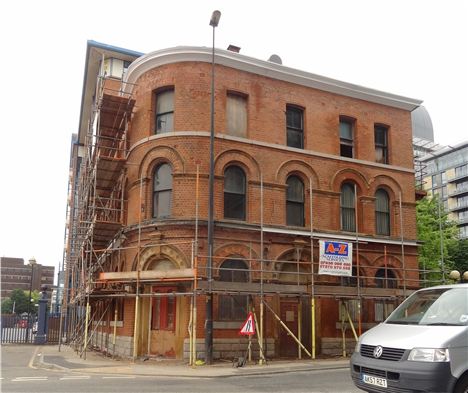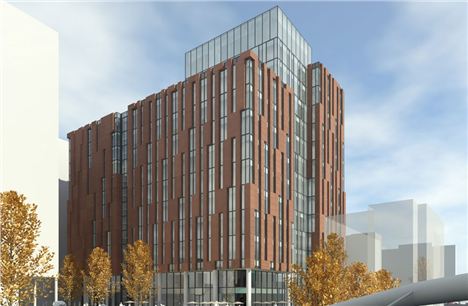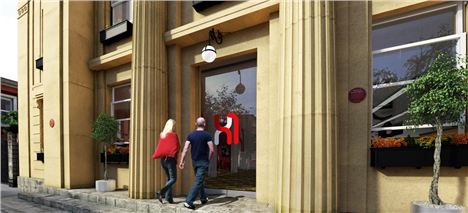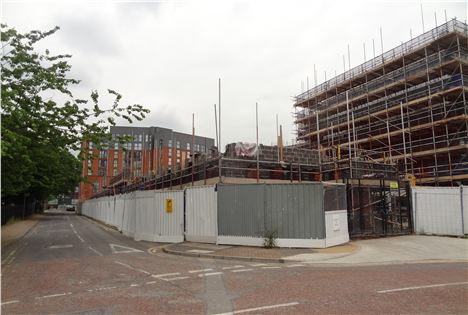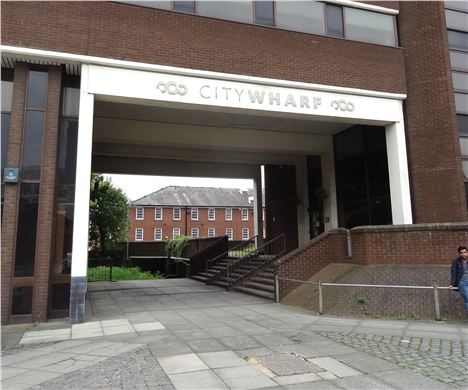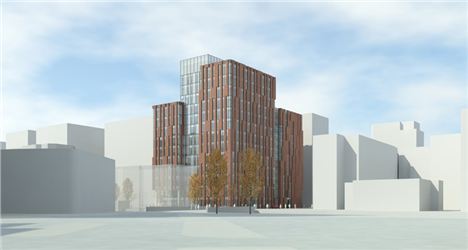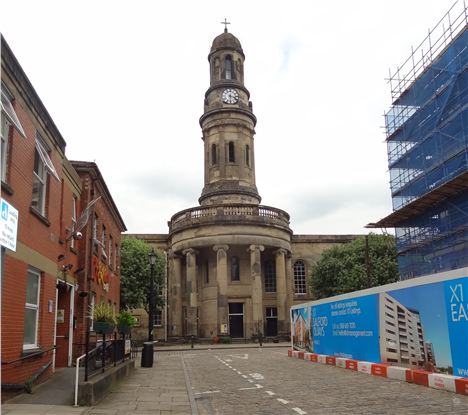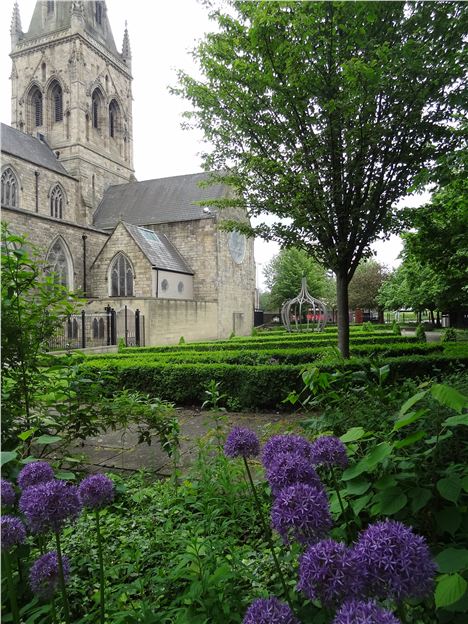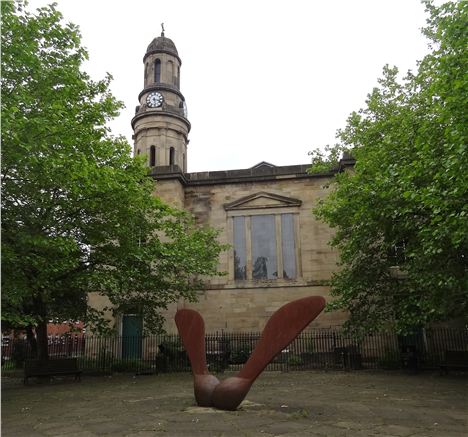THE REGENERATION of Salford Central and its environs has been the next big thing for as long as I can remember.
“We have a university, a Cathedral, two train stations, a river, new housing, hotels, and we're on the doorstep of Spinningfields, one of the most successful developments outside London."
Its proximity to Manchester made it an obvious next step for investors to bridge the River Irwell and continue the march of prosperity into another city.
But it never quite happened.
The Central Salford Urban Regeneration Company spent many millions but never did what it said on the tin. An increasingly desperate City Council gratefully agreed poor quality schemes and tinkered round the edges with random public realm work while buildings on Chapel Street were razed and burned.
The main route from the west into Manchester became a gap-toothed grimace of decay and the area little more than an off-street car park for Salford's glitzy neighbour.
Five years ago in May 2009, Salford adopted an ambitious development framework for a big swathe of the area, from the Irwell to Salford Central along Chapel Street to Oldfield Road. It was commissioned by the Urban Regeneration Company (URC) which little more than a year later was wound up when major funders, the North West Development Agency (NWDA) and the Homes and Communities Agency (HCA), pulled the plug on the staff heavy Salford Quays based quango.
The Framework mantle was taken up by the English Cities Fund (ECf), which this time harnessed a commercial developer in the shape of Muse Developments alongside Legal and General Property and the HCA in a joint venture to deliver change.
Its 73 pages long and you can read it here.
Phil Mayall is Development Director at the ECf and he has been involved with Salford Central since 2008. You have to admire the man’s tenacity. Still, he is from Oldham.
So finally... finally, stuff is happening in a joined-up place-making kind of way.
The first most people noticed was the annexing, or 'calming', of Chapel Street, and it’s still hugely controversial. Personally, I don’t see why they can’t have two lanes of calm traffic, not just one, to help keep things moving. Also why the quality of the realm design is so dreadfully uninspiring. The calming seems very aggressive.
Still, here we are, ready to walk Mayall's 50 acres. So we turn our backs on Chapel Street, head off down Trinity Way and tick off on-going development.
The old Brown Brother’s Building is being converted by Artisan into a 60 bed hotel called The Ainscow in tribute to founder Carol Ainscow.
It seems a long way off a touted autumn opening and the basic website does not give much away, but ECf are delighted this private investment is happening and have chipped in with some improved paving.
Under the railway arches to the busy Trinity Way and Irwell street junction where a nine-storey 615 space multi-storey car park is taking shape.
The design looks great - for a car park - far more inspired than the hotel and office element also under construction there. With direct access to the ring road it will free up the current surface car parking for more development. It will be operated by NCP and is due to open by the end of 2014.
Next door, Riverside House, once worryingly decaying, is now scaffolded and the roof is being repaired with the exterior brick cleaned. There's still no application in yet on what its future may be.
On the opposite side of the road a 143 bed Premier Inn is on track to be handed over in September and open by Christmas. Even Mayall admits that "the jury is out” on the design by RHWL Architects for such a prominent riverside location.
Next door to the hotel is Plot A5 earmarked for a 90 unit apartment scheme which they hope to start next spring. “There’s a lot of work to do between now and then," Mayall says about the potential development. "We don’t have planning or detailed designs but we are keen to keep things moving." Riverside apartments a short walk from Spinningfields should not take too much consideration.
Head into Spinningfields and across the new bridge (part of the framework plan) and while the dated Ralli Quays with its 1980s blue is staying, the demolition of Ralli Courts has begun to make way for One New Bailey, a speculative eight-storey office block with ground floor bars and restaurants. Construction is due to start in September, with hope that “a new public square, extensive landscaping and an outdoor events space” on the sunny side (Mark Addy side) of the river will deflect from the mundanity of the office design.
Next door Irish developers McAleer and Rushe got permission in 2012 to replace the dull brown City Wharf buildings with a 271 bed hotel and offices in a 12-storey tower.
Salford Central Station has already been vastly improved and it is hoped that work will be done soon to raise the platform - so you'll no longer have to risk a broken ankle getting off.
Back along Chapel Street, where crossing the Trinity Way junction takes ages, and into the historic Cathedral area. This bit of Salford has eighteen listed buildings, the Cathedral and former Town Hall among them.
The former Town Hall is being converted into 122 apartments by X1 Developments. They are already being sold on to investors with promises of a 6% net yield for five years. Advertised price is £84,950 for a 30sq m one bed. That’s tiny.
X1 is also developing student residential further along Chapel Street, again being sold on to individual investors.
The walk from the Town Hall behind the Cathedral to St Philips Church is unexpectedly leafy and tranquil, with random sculpture and squares the legacy of past regeneration initiatives.
A grassy plot here, officially F4, is earmarked for residential, more than likely to be town houses given the current demand from buyers.
Cathedral House is being renovated and will soon provide accommodation for priests, while the gardens have been replanted and are now a fine place for wedding photos. There are plans to open up more of the Cathedral site. The Diocese also owns the handsome former Education Offices building.
Facing across Chapel Street is Vimto Gardens, so named because the original Vimto factory stood just up the road. It will deliver 83 apartments and fourteen townhouses built around an inner courtyard with four retail units, including a supermarket, at street level.
The distinctive facade of the former Bell Tower pub frames the western edge of the scheme and thirteen units in this section will be the first to be completed in September, with the remainder due for completion in December.
Sales launch early next month.
While the apartments front Chapel Street, the townhouses are at the back with front doors onto Barrow Street and there will also be a first floor communal garden and courtyard parking.
This mix of apartments, townhouses, communal gardens and street frontage is a model that works well for Muse. Their Islington Wharf Mews scheme in New Islington is an example of how developers can provide good looking inclusive street scenes and still offer secure areas and private spaces.
Of the 800 or so inquiries that have been logged for Vimto since the scheme was first announced, around 30% have been for the townhouses. That Help to Buy is available on 100% of the properties will undoubtedly help sales. Get in while you still can.
St Phillips C of E Primary School (by Vimto Gardens) once at risk of closure, is now being extended.
We stop for a brew at Islington Mill, rescued from ruin by former St Martin’s College student Bill Campbell who is saving it one brick at a time and providing an outlet for all sorts of creative arts.
Mayall said: “This shows the ambition of what we are doing here. We have Islington Mill but we also have Grade A office space at New Bailey.
“We have a university, a Cathedral, two train stations, a river, new housing, hotels, and we're on the doorstep of Spinningfields, one of the most successful developments outside London.
“Salford Central is a place in its own right but it would be completely false of us if we did not see its proximity to Manchester as a huge opportunity.”
Is he convinced that this time it will work, that the investment and improvements and place making will be wholescale and long lasting?
“Salford had made previous attempts but it had been disjointed repairs and improvements, nothing joined up, no cohesive plan. Developers had no comfort that the whole area would be regenerated.
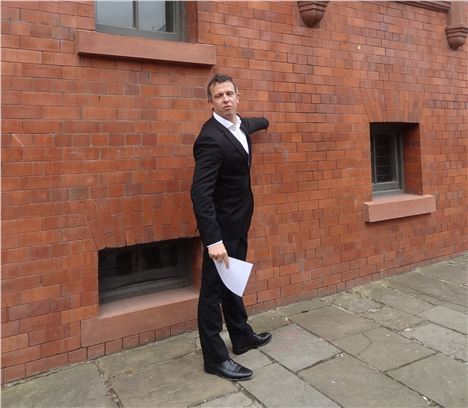 Phil Mayall has his hand eaten by a wall
Phil Mayall has his hand eaten by a wall
"A lot of time has been put into the framework and we do expect other developers and landowners to make progress to the same time scale as ECf.
“We have implementation agreements on three schemes and it removes the temptation for developers to sit back and simply wait for values to rise without making a contribution to the initial impetus.
“We have secured £100m investment in the last twelve months, more than the area has had in the last decade. We want to get the first elements done to help drive the area and lift values.
“To my way of thinking, if we can get the people back in, repopulate the area, then everything else should follow.
"It’s a long term view and comprehensive approach.”
More on the development of Salford Central and Chapel Street.
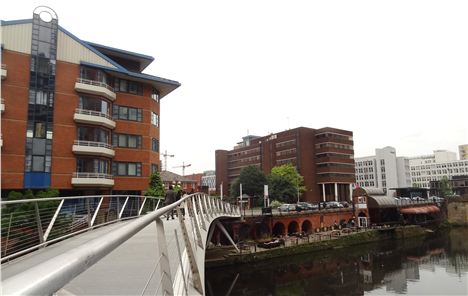 Ralli Quays (left), City Wharf (right)
Ralli Quays (left), City Wharf (right)
 Chapel Street Education Offices
Chapel Street Education Offices









